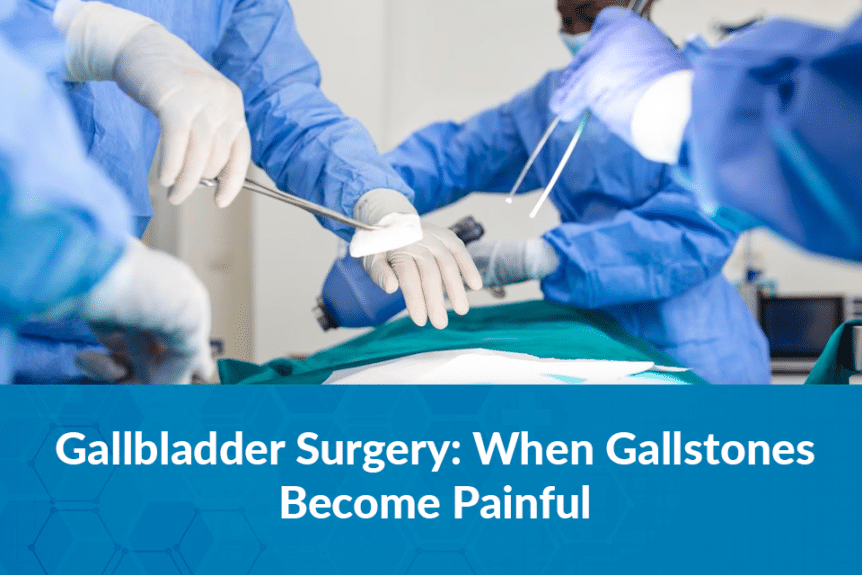
Gallbladder Surgery: When Gallstones Become Painful
Gallstones are very common findings during a routine right upper quadrant ultrasound or CT scan for abdominal pain work-up. Across the board, gallstones are seen in about 30% of patients in the United states. This condition is more commonly seen in patients who are older than 40 years old, slightly overweight, Hispanic, woman, and within the latter part of their childbearing age. How can a liver surgeon help in this condition?
While in the majority of patients, the stone do not cause symptoms (abdominal pain, discomfort, back pain, nausea, cold sweats, and vomiting), 15-25% of patients develop a severe abdominal pain leading to an emergency room visit. Some patients are even misdiagnosed with a heart attack, while the problem is actually the gallbladder and not the heart. Their cardiac diagnostic workup is uniformly normal.
When the stones start to cause obstruction of the cystic duct (duct that connects the gallbladder to the main bile duct), inflammation with infection of the gallbladder (cholecystitis) usually starts. E coli and Klebsille are the two most common bacteria found in the infected bile/gallbladder. The patients may develop fever, severe abdominal pain, changes in blood pressure, and even possibly sepsis (the bacteria from the infected gallbladder are now entering the systemic blood circulation causing a hemodynamic collapse). In cases of partial cystic duct obstruction, the patients maybe feeling an intermittent abdominal pain after eating heavy meals/fatty meals, a condition called biliary colic. The definitive treatment for these patients is gallbladder removal surgery, also known as cholecystectomy. Simply removing the gallstones is associated with near 100% recurrence of the cholecystitis, therefore it is not recommended.
Cholecystectomy can be done through a laparoscopic or robotic approach, depending on the experience and expertise of the operating surgeon. Laparoscopic cholecystectomy is the most common operation offered in our hepatobiliary center as an outpatient procedure. When the gallbladder removal surgery is anticipated to be technically difficult (liver cirrhosis, fatty liver, morbid obesity, presence of liver tumor next to the gallbladder, prior operation(s) near the liver, etc.), we prefer to use robotic cholecystectomy. The robotic system allows the surgeon to do more delicate dissections and place fine sutures when necessary. It is like driving a car with a modern GPS versus a bicycle.
The patient does not need to stay in the hospital following a laparoscopic or robotic cholecystectomy. Despite its straightforward nature, it is very important to find an experienced surgeon to perform this operation since the known complication of bile duct leak or injury (1%) can be fatal. When the gallbladder is severely inflamed from gallstones impacting the cystic duct, the risk of laparoscopic cholecystectomy increases.
Dr. Sucandy has extensive experience with laparoscopic cholecystectomy as well as robotic cholecystectomy. Liver surgeons have the most experience with this operation since they are very familiar with the anatomy (and its variations) of the surrounding organs. Dr. Sucandy has been the referral destination for difficult gallbladder surgery or bile duct leak repair after laparoscopic cholecystectomy from around Tampa Bay area in the past 6 years. Some patients come as far as 250-mile distance from the office to see Dr. Sucandy.
Many people asked “How to get rid of the gallstones?”. The answer is through laparoscopic or robotic cholecystectomy. Removing the stones via laparoscopic or robotic cholecystectomy also decreases the chance of stone migrating into the main bile duct causing an acute pancreatitis. This can be a very complicated problem/disease to manage since additional endoscopic procedures will be necessary to remove those stones from the main bile duct. Natural herbal medicine has not been proven to dissolve the gallstones. Bile salt thinner had been prescribed to help prevent gallstone formation but this medication has been shown any benefit in dissolving existing gallstones. Following a healthy low-fat diet is the key in gallstone prevention.

